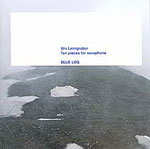Home » Jazz Articles » Album Review » Urs Leimgruber: Blue Log: Ten Pieces for Saxophone
Urs Leimgruber: Blue Log: Ten Pieces for Saxophone
Throughout the album, Leimgruber places more emphasis on the soprano saxophone than the tenor instrument, though he plays both. The pieces that showcase his tenor, such as the first and sixth tracks, are excellent examples of the way he transcends the sound of the instrument by placing emphasis on tongue slaps, shrills, rich multiphonics, and sharp altissimo in order to create something so alien that it would appear as if it were originating from another source. He creates brilliant phrases and imposes an overall structure on the implied techniques, lending an overall motive to the pieces.
The soprano pieces focus more on almost ear-splitting altissimo, swift tonguing, quick arpeggios, and recurring patterns. The fifth track is the most accessible piece on the album, featuring a more conventional approach to improvisation by playing a basic theme and returning to it. This is a very delicate, beautiful piece with its own share of altissimo notes, but it's not as abrasive as the others. With regard to motifs, the eighth track includes reed pops as well as a sporadic share of squawks and swift tonguing. On the final piece Leimgruber plays over a set of multi-tracked textures that use interior saxophone playing and vocal drones to provide a background over which he places the soprano in the foreground to build a cohesive whole.
Unfortunately, Urs Leimgruber is criminally underregarded. He is indeed one of the great European innovators on saxophone, on par with the likes of Evan Parker, John Butcher, and Mats Gustafsson, as well as American counterparts like Anthony Braxton and Roscoe Mitchell.
Blue Log is indeed Leimgruber's most intense and difficult solo album to date. I would not recommend it as an introduction to his work, unless you are already familiar with the solo catalogue by his aforementioned contempories—in which case this album may provide the missing link in reed transcendence.
Track Listing
1(08:32); 2(02:00); 3(03:50); 4(06:52); 5(05:04); 6(06:56); 7(04:08); 8(02:39); 9(05:16); 10(04:57).
Personnel
Urs Leimgruber
saxophone, sopranoUrs Leimgruber: soprano and tenor saxophones.
Album information
Title: Blue Log: Ten Pieces for Saxophone | Year Released: 2005 | Record Label: For 4 Ears Records
< Previous
Passing Place
Next >
Spring Cycle
Comments
About Urs Leimgruber
Instrument: Saxophone, soprano
Related Articles | Concerts | Albums | Photos | Similar ToTags
For the Love of Jazz
 All About Jazz has been a pillar of jazz since 1995, championing it as an art form and, more importantly, supporting the musicians who create it. Our enduring commitment has made "AAJ" one of the most culturally important websites of its kind, read by hundreds of thousands of fans, musicians and industry figures every month.
All About Jazz has been a pillar of jazz since 1995, championing it as an art form and, more importantly, supporting the musicians who create it. Our enduring commitment has made "AAJ" one of the most culturally important websites of its kind, read by hundreds of thousands of fans, musicians and industry figures every month.



















